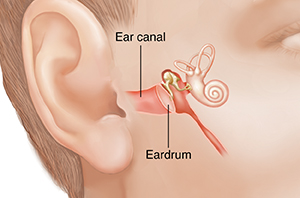Impacted Earwax
Impacted earwax is a buildup of the natural wax in the ear. Impacted earwax is very common. It can cause symptoms such as hearing loss. It can also make it hard for a health care provider to check your ear.
Understanding earwax
Tiny glands in your ear make substances that combine with dead skin cells to form earwax. Earwax helps protect your ear canal from water, dirt, infection, and injury. Over time, earwax travels from the inner part of your ear canal to the entrance of the canal. Then it falls away naturally. But in some cases, it can’t travel to the entrance of the canal. This may be because of a health condition or objects put in the ear. With age, earwax tends to become harder and less fluid. Older adults are more likely to have problems with earwax buildup.

What causes impacted earwax?
Earwax can build up because of many health conditions. Some cause a physical blockage. Others cause too much earwax to be made. Health conditions that can cause earwax buildup include:
-
Bony blockage in the ear (osteoma or exostoses)
-
Infections, such as an outer ear infection (external otitis)
-
Skin disease, such as eczema
-
Autoimmune diseases, such as lupus
-
A narrowed ear canal from birth, chronic inflammation, or injury
-
Too much earwax because of injury
-
Too much earwax because of water in the ear canal
Putting objects in the ear again and again can also cause impacted earwax. For example, putting cotton swabs in the ear may push the wax deeper into the ear. Over time, this may cause blockage. Hearing aids, swimming plugs, and swim molds can also cause this problem when used again and again.
In some cases, the cause of impacted earwax is not known.
Symptoms of impacted earwax
Excess earwax often does not cause any symptoms, unless there is a large amount of buildup. Then it may cause symptoms, such as:
-
Hearing loss
-
Earache
-
Sense of ear fullness
-
Itching in the ear
-
Odor from the ear
-
Ear drainage
-
Dizziness
-
Ringing in the ears
-
Cough
Treatment for impacted earwax
If you don’t have symptoms, you may not need treatment. Often the earwax goes away on its own with time. If you have symptoms, you may have one or more treatments, such as:
-
Ear drops to soften the earwax. This helps it leave the ear over time.
-
Rinsing the ear canal with water. This is done in a health care provider’s office.
-
Removing the earwax with small tools. This is also done in a provider’s office.
In rare cases, some treatments for earwax removal may cause complications, such as:
Talk with your provider about which risks apply most to you.
Caution
Health care providers don't advise using ear candles or ear vacuum kits. These methods are not shown to work and may cause more problems.
Preventing impacted earwax
You may not be able to prevent impacted earwax if you have a health condition that causes it, such as eczema. In other cases, you may be able to prevent earwax buildup by:
-
Using ear drops once a week
-
Having a regular ear cleaning about every 6 months
-
Not using cotton swabs in the ear
When to get medical advice
Contact your health care provider right away if you have:
-
Symptoms of impacted earwax.
-
Severe symptoms after earwax removal, such as bleeding or severe ear pain.